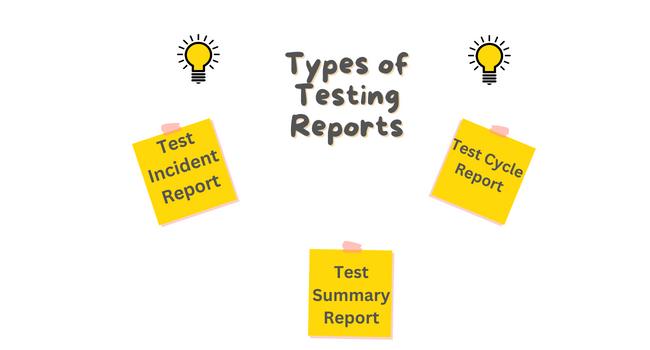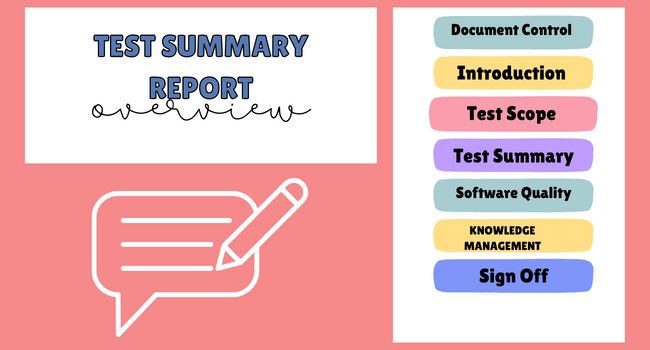

Test summary report in software testing is a crucial deliverable of the testing process. A well-written testing summary report explains various details about testing cycles, project quality, and project situations to product managers and stakeholders. Based on this report, the stakeholders decide if the application is ready for release.
However, if your summary report doesn’t effectively portray the end-to-end testing process or fails to report existing bugs, stakeholders won’t be able to understand the product situation. As a result, releasing a faulty product would lead to a bad reputation and loss of stakeholders’ trust.
So, you understand how important it is to write an effective test summary report. However, summarizing the entire testing process can become overwhelming. To help you, we have explained the process in a detailed manner along with a template you can follow to write efficient summary reports.
Table of ContentsTest summary report in software testing is a formal document that summarizes the results of all testing efforts for a particular testing cycle of a project/module or a sub-module. It acts as a quality gate for the product or application to determine if it’s ready to be released.
Ideally, a test summary report should be prepared after the completion of each test cycle so that a correct summary of the entire testing effort & health of the application can be presented to relevant stakeholders.
All relevant stakeholders of the project are able to see the health of AUT from this report. It will also help them to take necessary steps proactively if required. More importantly, it will justify the testing effort the testing team is putting into the project.

Test reports ensure effective communication between QA team members, the product manager, and stakeholders. There are mainly 3 types of test reports.
Test incident report mainly includes the bugs & issues found during the testing process so that they can be fixed by relevant team members. The bug or defects are reported as incidents and added to a defect repository. Each incident has a unique id to identify it.
The most severe incidents or defects are highlighted so that they can be resolved first. Additionally, major incidents are added to the test summary report.
The test cycle report is essentially a summary of everything that occurs throughout a single cycle. It describes the tests that will be executed and the builds that will be tested in this cycle.
Additionally, includes new bugs discovered during that cycle, bugs resolved, and outstanding bugs that have yet to be fixed. You’ll also need to report on progress made in this cycle as well as any schedule changes that occurred.
The test summary report is prepared at the end of each cycle or at the very end of the project. It gives a verdict on whether the software is ready for release or not. It is a formal document that summarizes the results of all testing efforts for a particular product.
Test summary report works as a means of communication between the testing team & the stakeholders. This report allows the stakeholders & upper management to understand the quality of the product, as well as the effort the testing team had to put in to get it to this shape.
If test summary reports are not detailed & informative, the stakeholders wouldn’t understand the current position of the software. As a result, they can end up sending a defective product into production or releasing it to the public. This will lead to massive loss of money & company image.
When stakeholders face such loss, they won’t trust your QA team anymore. As a result, you’d lose potential clients too.
Therefore, writing an effective test summary report is of utmost importance. This ensures good product quality and trust between stakeholders & QA team.
The benefits of writing an effective test summary report are manifold. Here are a few of the most important ones:

To write an effective testing summary report you need to include all the necessary parts in it. We’ve given a brief explanation of how to write an effective test report including the must-have parts:
You have to include two main points in Document Control: Revision History and a Distribution List. The revision history includes information about when the test summary report was prepared, when it was last updated, what was updated, etc.
Distribution list should contain all the people involved in the testing process such as the test manager, test leads, and test engineers. It must also contain the name of stakeholders or product managers who have reviewed the test summary report.
In this step, you have to provide the necessary project information like name, version, etc. Also, give a brief description of what the product is about and what features it entails.
Additionally, you have to state the purpose of creating the testing summary report. The main purpose of creating this report is to summarize the testing efforts, as well as list the test environment, results, and bug reports.
List the functions that are inside the scope of your testing plan. Also, write down modules that are out of scope, as well as areas that haven’t been tested and the reason behind excluding them.
This section contains a summary of everything required for test execution such as metrics used, test environments, types of tests performed, etc. Graphs and charts can be used for better and clear portrayals of the metrics.
Also, include test suite data like the number of test suites planned, executed, and test suites not executed. Moreover, include test case data such as the no of test cases planned, implemented, passed, and failed.
Make tables for listing the different tests performed on the product such as Smoke, Regression, and Integration testing. This ensures the stakeholders that the application has been tested as per the test strategy.
In this step, describe the major challenges encountered and the remedies adopted to overcome those issues during testing. Important aspects that must be included in this step are:
Summarize the test results of all the testing executed in each cycle of the STLC. You can add the Execution Report for more clarity. Additionally, insert snapshots of manual and automation test results.
Categorize bugs found during testing by status. Add a defect report if necessary. Also, make a defect matrix based on defect priority or severity. Include details about total open bugs, new bugs found, open bugs of previous release, reopened bugs, bugs marked as “Not a Bug”, and bugs marked as “Deferred”.
During testing, often it is not possible to fix every defect identified. Describe such defects that are still present in the application along with why it’s not been fixed.
Define the exit criterion for each test and offer an assessment to determine whether the product meets the exit criteria. Be specific about criteria that weren’t satisfied.
Mention any lessons you learnt throughout testing, as well as any issues that required special attention. Also, emphasize the testing team’s outstanding work in ensuring the product’s quality.
Make a list of enhancements that could be included in future testing initiatives. Also, include any remarks or suggestions for the stakeholders.
Finally, in this step reveal if you think the application is ready for deployment or not. As a test manager or test lead, state your opinion on whether the application needs further improvement or it can be released to stakeholders.
Test Suite Data:
Risks / open issues / support required:
Deviations from signed off test plan:
Some other information can be part of test summary report:
Here’s a sample template for writing an effective testing summary report. Use it to write your application’s test summary report.
| Version | Date | Author | Summary of Change |
| Role | Name | Date | Remarks |
| Test Manager | |||
| Test Engineer | |||
| Reviewed By (Role) | Name | Date | Remarks |
| Stakeholder 1 |
| Project Name |
| Product Name |
| Product Type |
| Product Description |
| Project Duration |
| In Scope | Out of Scope | Not Tested | Reason |
| Test Cycle | Timeline | Finish Date | Status | Remarks |
| Cycle 1 | 05/07/2022 – 25/07/2022 | 27/07/2022 | Completed |
| Test Cycles | Total Number of Test Cases | # of Test Cases Executed | # of Test Cases Passed | # of Test Cases Failed |
| Cycle# 1 | ||||
| Total # TCs |
| Defect in Phase | Severe | High | Medium | Low | Lowest | Total |
| Cycle# 1 | ||||||
| Totals |
| Criteria | Met/Not Met |
Mainly the test manager or test lead is responsible for the testing summary report. However, the entire testing team helps in preparing the report effectively.
There are two types of test summary report: Phase-specific report and Conclusive report. The former detects targeted areas of the application life cycle areas for referral, whereas the latter is a document of fitness for the application.
Requirements Traceability Matrix is a document that proves that requirements defined for a product are verified in the testing process. It also assures that they have been thoroughly tested in terms of test parameters and methodologies.
The testing summary report is a crucial communication tool for test managers and stakeholders. It should be detailed, clear, standard, and specific. Moreover, it must explain test activities in a way that non-technical recipients can also understand them.
This report is evidence of test engineers’ efforts during the testing phase. It helps the stakeholders in deciding whether or not to release the product.
Once the test summary report is ready, they must also be shared with the testing team. An effective test summary report provides team members with an overview of the complete testing cycle, allowing them to improve further.
Rahnuma is a technical content writer at software testing stuff. A software engineer by degree and a dynamic content creator by passion, she brings to table over 3 years of writing experience in tech niche. Combining her enthusiasm for writing and technology, she loves to share her thoughts on the latest tech trends.
Latest posts by Rahnuma Tasnim (see all)